|
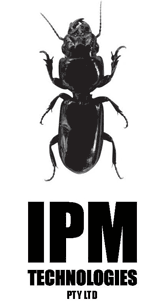 
|
|
Dr Paul Horne
IPM Technologies P/L
PO Box 560, Hurstbridge,
Victoria, 3099, Australia
(b) 03 9710 1554
(f) 03 9710 1354
(e) ipmtechnologies@bigpond.com
(w) ipmtechnologies.com.au
|
Expertise:
|
|
Dr Paul Horne � Vegetable Researcher of the Year
The prestigous AusVeg 2009 Vegetable Researcher of the Year Award was awarded to Dr Paul Horne of IPM Technologies P/L for his ongoing contributions to vegetable research in the field of Integrated Pest Management.
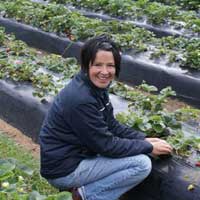 Paul recognised the valued contribution of his colleague Jessica Page in the development of successful pest management strategies for many of our food crops. Paul recognised the valued contribution of his colleague Jessica Page in the development of successful pest management strategies for many of our food crops.
Paul and Jessica have worked together since 1995, developing and implement IPM Strategies and training programs across a wide range of horticultural and broad-acre crops and pastures.

|
|
” Predatory insects and mites are our first line
of defence against pests in our food crops “
|
|
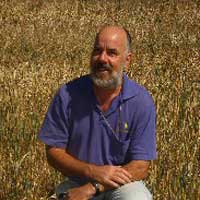 Encouraging beneficial insects to help protect our crops from pests, first succeeded in controlling a variety of pests in potato crops in the 1990’s. The development of this approach is chronicled in their Review of Potato IPM in Australia. Encouraging beneficial insects to help protect our crops from pests, first succeeded in controlling a variety of pests in potato crops in the 1990’s. The development of this approach is chronicled in their Review of Potato IPM in Australia.
Paul and Jessica are now developing IPM controls for the Potato Psyllid, which is currently causing havoc throughout New Zealand. Their work aims to expand the understanding and adoption of IPM strategies on farms across Australia and New Zealand.
|
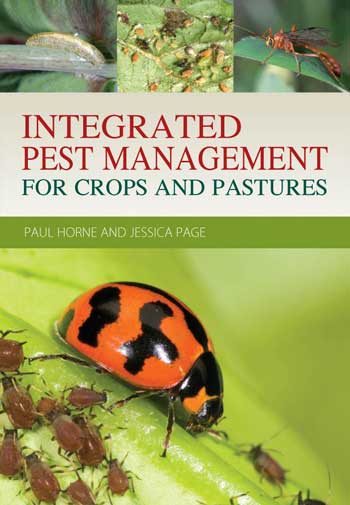
IPM for Crops and Pastures
Paul Horne & Jessica Page
Describes in straightforward language how farmers can successfully apply Integrated Pest Management (IPM) to their cropping and grazing operations.
The book explains the advantages of IPM over conventional pesticide-based control methods.
This book will help farmers wanting to apply IPM on
their properties outlining what to expect when changing
to an IPM strategy.
Topics include:
- Why insects and mites become pests?
- Factors that increase pest pressure
- Environmental factors beyond our control
- Descriptions of pest species
- Descriptions of beneficial species
- Examples of cultural control
- Integration of cultural controls
- Pesticides on beneficial insects
- Pesticides and organics
- Pesticides and IPM
- Selecting your first IPM paddocks
- Specific examples of monitoring with some selected scenarios
|
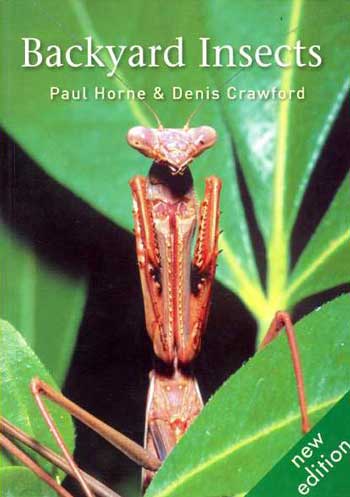
Backyard Insects
Paul Horne & Denis Crawford
Love them or hate them, we can’t avoid the insects that share our homes and gardens.
Crawling with full-colour, larger-than-life photographs, Backyard Insects is a fascinating guide to the bugs of urban Australia.
The book contain images of common or important species representing most groups of terrestrial insects.
Paul Horne tells us many details of the often bizarre life cycles and behaviour of backyard insects.
Denis Crawford’s extraordinary photographs vividly capture the colour and personality of the bugs, placing in a new light the cockroach in your cupboard and the silverfish in your kitchen sink.

|
|
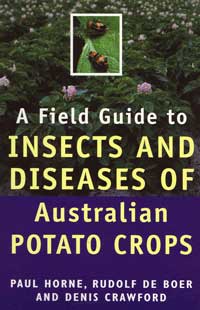 Field guide to Insects and Diseases of Australian Potato Crops Field guide to Insects and Diseases of Australian Potato Crops
Paul Horne, Dolf deBoer & Denis Crawford
Insects and Diseases of Australian Potato Crops (2002) is the best reference for Australia’s commercial potato growers & advisors andbackyard gardeners.
Accurate identification of the most common pests, diseases and beneficial species is essential for good crop management.
This book presents the results of extensive research and includes both beneficial insects as well as potato pests.
Beneficial species are largely responsible for ‘unseen control’ of plant pests, but are vulnerable to most insecticides.
This book is well illustrated & easy to use, it will assist all potato growers avoid costly mistakes.
|
Development and implementation of IPM strategies to cropping systems in Victoria
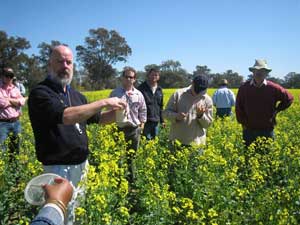 This paper discusses the development and implementation of IPM strategies for broadacre cropping in Victoria, with reference to other crops in Australia and overseas. This paper discusses the development and implementation of IPM strategies for broadacre cropping in Victoria, with reference to other crops in Australia and overseas.
- Levels and rates of adoption are mostly low but there are some exceptions.
- The reasons for differing levels of adoption include:
- the failure of strategies to successfully deal with all pests.
- the lack of motivation to change to IPM given successful pesticide-based controls.
- poor availability of IPM advisors in the field.
- It was found that although there were no existing specific IPM strategies for the crops grown in the region of south-eastern Australia, there was sufficient information for farmers to start using an IPM approach.
This paper gives a case study of implementing change to IPM from conventional pesticide spraying, including the development of a course in IPM for growers and agronomists.
|
Population ecology of spiders in Australian wheat agroecosystems
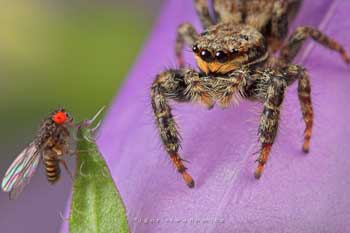 The predatory role of spiders in wheat systems has been researched a great deal The predatory role of spiders in wheat systems has been researched a great deal
worldwide. However in Australia almost nothing is known about the spider communities
in broad-acre cereals.
Over two years of sampling, this foundation study in South-Eastern Australian wheat gathered basic ecological information on the composition,
persity, abundance and phenology of the spider population.
Synchronicity between the
spider community, pest insects and the crop cycle is explored whilst remarking on the
potential influence of drought. Comparisons between the Australian fauna and other
continents are drawn.
|
|
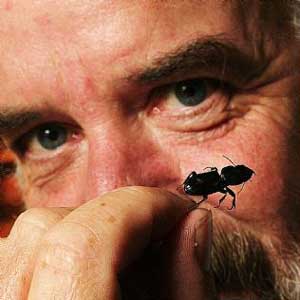 Carabids as indicators of sustainable farming practice Carabids as indicators of sustainable farming practice
Carabid beetles are important biological control agents in a range of agricultural crops throughout the world. This paper outlines the history of carabid research in Australia to provide a point of reference with European and USA studies.
The ecological and applied agricultural knowledge of the Australian fauna lags far behind that of Europe and the USA but we are now at the point of using the available knowledge to assess agricultural ecosystems.
This paper describes how aspects of the biology and ecology of the Australian carabid fauna differ from that described in published work on other carabid populations.
|
|

VG 06088 Providing an IPM Advisory Service for Tasmania
This project demonstrated IPM in action in a range of glasshouse and outdoor vegetable crops in Tasmania.
Currant Lettuce Aphid is an insecticide resistant pest that arrived in Tasmania from New Zealand in 2004. Jessica Page and Paul Horne were challenged by industry to demonstrate that an IPM approach could deliver an practical alternative to insecticide drenches.
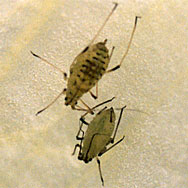 The level of control achieved in susceptible varieties of lettuce, without insecticide, was shown to be equal to that achieved by insecticide drenches. The level of control achieved in susceptible varieties of lettuce, without insecticide, was shown to be equal to that achieved by insecticide drenches.
The demonstration showed that IPM is a viable alternative to routine pesticide applications. Growers and agronomists attending the trial agreed that they have a better alternative to a totally insecticide based option and can understand how control of other pests can fit within an overall IPM strategy.
The positive reaction of growers and agronomists was most encouraging.
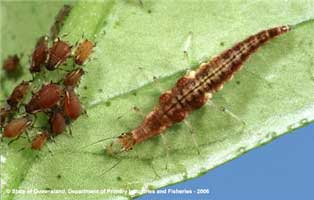
Related work : Lettuce Aphid (Nasonovia ribisnigri)
VIDEO CLIPS
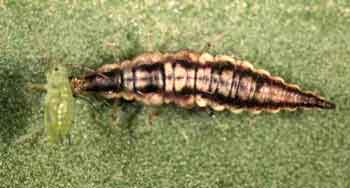
|
|
VG 06087 Pesticide Effects on Beneficial Insects and Mites
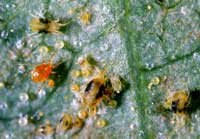 This project provided growers and advisors with regular, up-to-date information on the effects of pesticides(insecticides, fungicides and herbicides) on key beneficial species found in vegetable crops. This project provided growers and advisors with regular, up-to-date information on the effects of pesticides(insecticides, fungicides and herbicides) on key beneficial species found in vegetable crops.
Many pesticides claim to be harmless to non-target species, yet there have been few tests on beneficial insects.
The project provided the information growers need to make informed decisions on thecompatibility of pesticides with biological control and IPM.
Existing sources of information are inadequate or misleading and so this project will address that problem and allow better 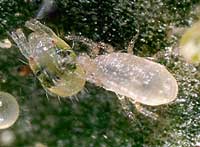 adoption of IPM. adoption of IPM.
|
|
VG 06086 Scoping Study on IPM Potential and Requirements
 This project identified the practical capabilities of IPM services around Australia. This project identified the practical capabilities of IPM services around Australia.
A survey of growers and advisors found:
- About half the growers surveyed currently use IPM but this varied greatly between states.
- 80 per cent of those who had used IPM continue to use the strategy.
- Many growers believed they were using IPM when they were not.
- IPM adoption was limited by the convenience of effective pesticide solutions.
There is good awareness of IPM, but the benefits and practicality of the strategy need to be demonstrated before further change will occur.
|
|
|
VG 05008 Cultural control methods for pests of Leafy vegetables
This project investigated the potential for specific cultural methods to improve pest control within IPM strategies using Western Flower Thrips as an model pest.
Biological control of pests such as aphids is often poor when a new crop is planted, as there is a lag between the arrival of the pest and the build-up of predators and parasitoids.
Cultural controls are under-utilised management options that will assist in the control of pestsby either discouraging pests or encouraging beneficial species (predators).
Cultural controls are very powerful but are often overlooked, even by growers using IPM. This project identified severalpractical cultural controls to encourage beneficial insects and mites and help control of a range of pests.
Cultural control methods have to be practical and fit with existing farm practices. A very simple method of increasing populations of beneficials is to plant strips of cereals in Spring, ahead of the vegetable crop.
The cereals provide habitat for non-pest aphids that maintain populations of lacewing predators.
Aphids in cereals do not affect the vegetable crops but the predators eat ALL aphid species. In this way it is possible to favour predators of aphids without risking damage to vegetable crops. This strategy is succesful when aphids are a serious pest, such as in lettuce crops.
Composted Fowl Manure can increase populations of soil dwelling predatory mites, like any decaying organic matter. Wesuggest that the provision of any organic mulches and crop residues, should encourage resident populations of predatoryinsects and mites.
One of the most important finding from this project is that control of Western Flower Thrips in leafy vegetables can be achieved using insect and mite predators as part of an IPM strategy.
There are a range of predators of thrips that occur naturally, that can be encouraged by cultural practices, and that are effective in controlling WFT when insecticide-based approaches fail.
Early plantings of plant species (eg along sprinkler lines or boundaries) can be used to establish populations of key biological control agents such as brown lacewings.
|

|

|

|
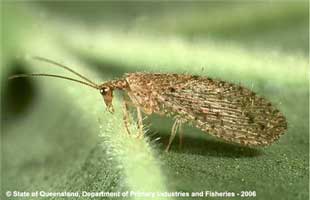
|
|
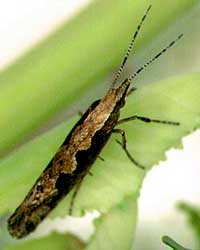 VG 05007 Demonstrating IPM in Brassica crops VG 05007 Demonstrating IPM in Brassica crops
This project demonstrated IPM in brassicas and encouraged immediate adoption across Australia.
Increased adoption of IPM by growers was achieved by:
- having IPM experts standing in growers paddocks giving them information on how to implement IPM.
- encourage crop scouts/ advisors and consultants to attend the demonstrations as they will be able to provide on-going IPM advice once growers begin to demand it.
- VegeNotes – Diamondback Moth
|
|
VG 99070 Development of an IPM program in Celery
 Researchers identified and listed a range of pests affecting celery crops and developed a management strategy involving biological controls, cultural techniques and selective chemical use, in a three-year project ending in 2003. Researchers identified and listed a range of pests affecting celery crops and developed a management strategy involving biological controls, cultural techniques and selective chemical use, in a three-year project ending in 2003.
Celery-growers worked closely with researchers to implement the IPM strategy immediately, resulting in significant changes to their pest control regime within a relatively short time.
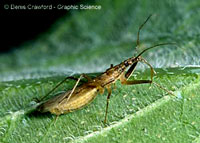 Prior to the project there was little grower awareness of the different pest species that could cause damage in their crop and no awareness of the actual/potential presence of beneficial insects in celery crops. Prior to the project there was little grower awareness of the different pest species that could cause damage in their crop and no awareness of the actual/potential presence of beneficial insects in celery crops.
Conventional pest control was based on regular and frequent use of broad spectrum insecticides. Aphid borne disease increased because beneficial insects were removed without complete control of aphid vectors.
Insecticide resistance had reached the level where a new approach was required. A farm based approach was taken withResearch and Extension, focusing on the farms of grower participants and bringing together researchers, other growers andchemical resellers.
|